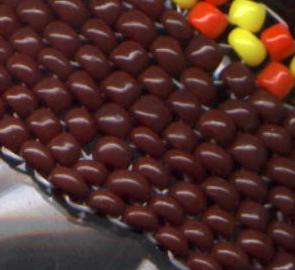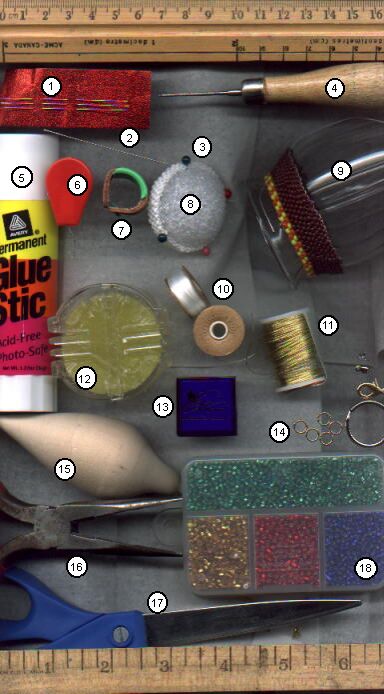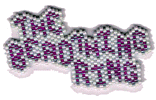





All beading graphics on this page were created by Kimberly Chapman, and are my exclusive property. Feel free to link to this page, but please do not steal the graphics and pictures. It took hours of work to make them. If I find them elsewhere on the Internet, I will consider pursuing legal charges against the site owner.
Beading can be a very rewarding hobby craft and even an art form. It can also be very frustrating if you don't have the temperament for it. I would advise that you NOT get into beading if any of the following characteristics describe you:
If none of these things describe you, or you're quite certain you can work around one or two that do, you may enjoy beading!
I work primarily with seed beads, those small ones you can buy in most craft stores that kids put on safety pins as "friendship pins." The ones from craft stores are generally cheap, and thus sometimes not all of equal size. In general, though, the size I'm working with is known as 11/0 (though some are marked as 10/0), which means if I line them up on a desk edge to edge, flat side down so they don't roll, there are roughly 11 of them in an inch. For some colours, I purchase glass beads of this size either at a bead specialty store, or sometimes I can find a separate section of glass beads within the big craft stores (hint: in Michaels, look for Mill Hill brand in the sewing/cross stitch section, not the bead section). These are more expensive, but sometimes I find I need the specific colour.
Note that the cheap beads can often differ in height, even amongst a single colour. This can really wreak havoc on a pattern if you're not careful.
 d d |
In this sample, you can see that there are 15 beads per inch with the white beads, but only 14 per inch with the translucent gold. Other colours vary between 12 and 17 per inch at the extremes. |
 d d |
Note how different the brown beads are from one another in height, and how the orange and yellow ones are also different. |
It's fine to have beads that vary a bit for beaded flowers, because there are so many beads wrapped around that it really doesn't matter. Some say it gives the flowers a more "natural" look. But for extensive stitched projects, you will probably want more uniform (and thus more expensive) beads such as Japanese 11/0s or Delicas.
The single most important hint I can give to anyone getting into this is to buy your beads pre-sorted by colour. Sure, if you're really looking to save some money, you can buy bags of mixed colours. But trust me, sorting them is a pain, and any time you're going to follow a pattern or try to do something specific, you'll have to poke around constantly to find the colour you want in that big mess. I buy by colour, then keep them in segmented plastic containers, such as those sold for keeping embroidery floss, or in glass jars for larger quantities. A hint when selecting a segmented box: press down on the lid in the middle. If it gives at all, as in it's not completely flush with the walls that separate the spaces inside, then every time the box gets jolted, turned, or upset, your beads will get mixed up. This is a right pain. It is worth the couple extra dollars to have a box where the lid is flush with the tops of the separations.
You'll also need beading needles. Regular sewing needles will almost always be too large to fit through the holes of most beads, particularly expensive ones like Delicas. Pretty much no seed bead will allow a normal needle through if you've had to pass the threat through several times, as is often required. I bought a set of I think five beading needles from Michaels, in the bead section near the beading thread, for under US$2. Fire Mountain Gems also sells beading needles.
As for thread, start with the inexpensive beading thread that should be in the same section as the cheap seed beads. Don't even try it with embroidery floss; that stuff will catch inside the beads, separate, tangle, and annoy you. Regular sewing thread is probably okay, depending on what you're doing, and does come in different colours, but beware that really cheap normal thread will also fray and tangle. You can improve thread quality with beeswax, which I found in the sewing section of Michaels in a handy plastic container that lets you run the thread through without handling the wax itself. This was only a couple of dollars. Even better is Thread Heaven, which you won't find in a typical craft store, but beading stores such as Fire Mountain Gems carry it. It's a bit more expensive, but it works very well, and doesn't clog up the holes of the beads like beeswax can.
Also, get yourself a decent pair of sharp scissors, not a crappy pair where the blades don't meet evenly. You can get one at a craft store, business supply store, or many other places. Expect to pay at least US$8-10 for scissors; if you find a three pack for a buck, those scissors will suck! Dull, poorly made scissors make life annoying when you're trying to trim thread very close to a tiny bead. And once you have nice scissors, don't use them to cut wire or other hard stuff. That'll wreck the blade. If you have a spouse or kids that regularly make off with scissors and often use them for incorrect purposes like this, hide them or tie them to your beading case (the scissors, not the family members).
While you're in the sewing section of the craft store, try to find Singer brand needle threaders: the red plastic ones as opposed to the little tin ones. I found the little tin ones fell apart really fast, while the plastic ones at three for 99 cents have been wonderful. And since you'll be taking your needle off a lot, having a threader is really important.
I also like to use small plastic segmented boxes to have a few beads handy on my lap. These boxes are cheap and great; I can carry them anywhere without the beads getting mixed. A larger compartment holds a threader, a spool, a needle, and even small amounts of completed beadwork, while three small compartments hold beads by colour.
Here is a scan of some basic supplies, with a rulers (metric on top, imperial on bottom) to give you an approximation of size:
 d d |
|
You may also want a bead spinner, which is a tool that puts many beads on wire or thread quickly. You can buy one, or make your own.
I also regularly collect things that I can use for beading later. Empty prescription pill containers could serve as bead holders, or an item to put beads around (although they should be washed thoroughly first). Old incandescent lightbulbs that have burned out make great forms for beaded hot-air balloons (I'm working on one now, and will take pictures and post it when it's done). This means I'm creating less garbage, and getting cheap beading stuff. Win-win!
Don't like my colour and font style? View this page in your default settings.
Page last updated December 4, 2003.
Email me at crafts@kimberlychapman.com
 d d |
The Bead Thing Ring
This BeadThing Ring site is owned by Kimberly Chapman. |
 d d
|
If you want to receive notification of updates on any portion of this site, simply enter your email address here and click/select the button to enter. You will be required to sign up for a free Yahoo! account to complete registration. Please note that Yahoo!'s privacy policy and other management are outside of kimberlychapman.com's responsibility. Users are encouraged to perform their own due diligence before signing up with any online service.
To find out more about the list or read messages without signing up, please visit the Yahoo! page for the kimberlychapman updates mailing list.
For more information on what these tags mean, please see About KimberlyChapman.com.